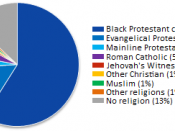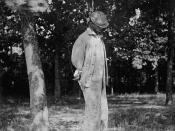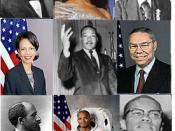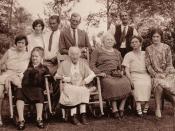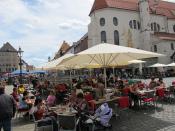Diversity in Augusta GeorgiaCommunities where we live has been working to be more diverse for years. When we step out of our houses or go to work we see people of many different races and backgrounds. But how diverse is our community really? How do our leaders treat people like you and me? Is there anything that we can do to help fix the problems?According to an article in the Augusta Chronicle, Augusta Georgia has always had a diverse population (2005). From as far back as when the city was created in 1736, the City of Augusta has been home to a diverse population. Starting with the English, who founded the city, to the Chinese, who helped build the canal, each group has made a long term investment to help the city grow. Today, Augusta is the second largest city in Georgia with a population of 195,769 people (2005).
According to the United States Census Bureau report in 2006 the percentage of Caucasians in Richmond County is 44.1% , African Americans 52.3%, American Indians 0.3%, Asian Americans 1.7%, and Hispanics 2.6%. With this, Georgia as a whole is 66.4% White Americans, 29.6% African American, 0.3% American Indian, 2.7% Asian American, and 6.8% Hispanic American. This makes Richmond County one of the most divided counties in the country.
Just because the population is diverse does not mean that where we live, work, and shop are as diverse. When we step out of our front door and look at our neighborhood I donÃÂt see the same numbers and figures that are released each year. In my neighborhood everyone looks just like me. We all do about the same things around the same time and there are little to no problems between households. My community is mostly white with a few of each race. But letÃÂs look at someone from the other side of town. Keith Walker, who is an African American living on the south side of Augusta, has a different story. KeithÃÂs neighborhood is just the mirror image of my neighborhood. He has mostly African Americans and a few but small mix of each of the other groups. According to Keith his neighborhood does not work well together. Their crime rate is very high. Keith said, ÃÂLast year alone, the white family at the end of the block was robbed four times and their cars were vandalized, but you donÃÂt see this happening to any of the Asian families or the Hispanic families. Our kids take what we say to heart and act on it. This is costing the Black family just because we are not teaching our children to get along no matter what the skin color.ÃÂ This does not happen just in KeithÃÂs neighborhood; there are other neighborhoods with the same problems, but it may be Caucasians doing the harm. According to the Census Scope, on Richmond County neighborhoods broken down by race, a predominately white neighborhood is 61.5% white, 31.9% black, 2.9% Hispanic, and 1.7% Asian. A predominately black neighborhood is 27.9% whites, 66.3 % black, 2.6% Hispanic, and 1.3% Asian. The way our community is broken down we need to work together as one and teach our children to understand that the color of skin does not affect who a person is. This is the only way to stop the hate crimes in all of our communities.
Our communities are not the only place for diversity. When we leave our homes and go to work we also see diversity. At Club Car, the company has a very diverse mixture of workers. The company takes the time to understand that in our area there are people that speak other languages other than English. Club Car offers information in more than one language for people that donÃÂt speak English as a first language. At the same time Club Car even offers English classes to help people that want to learn the English language. The company talks about how we are EOC compliant and we donÃÂt discriminate against anyone. On the outside you would see that Club Car is diversified. But is my work place as diversified as we are made to believe? No, when looking at how the population is broken down you would think that at least 50% of our management staff should be African American. When I go to the monthly meeting with all the management, I look around the room and see a different picture. In our top management we have all Caucasians. Yes, there are a few other races in middle management, but not many. Even when you look at our web site in every picture there are only white people used to help sell our products. Even though the company sees itself as diversified, because it meets the federal mandated mixture of race with in the company, it is not mixed in positions of importance. Even though the positions are not evenly mixed, we seem to have little problems between any of the workers. My company works to meet the needs of everyone. We have several ways to report problems in our facility. Employees can leave a letter in one of seven boxes with in the plant, they can talk to any member of management at any time with our open door policy, and if they donÃÂt feel that this will work, we have a third party company that takes calls where an employee can leave an anonymous complaint at anytime. Club Car makes it to where everyone can get along.
Our communities and work places are growing more and more diverse every day as our community grows. When we look at our government in our area we still see how diversified we are. In Richmond CountyÃÂs government, we see a more even mix or race in our leadership roles. Over the years African Americans have been in almost every government position. From being state senator to mayor of Augusta they have shaped the way for a more diversified state. But how well does our local government work? According to an article by CNN, Richmond County has been a very divide government. In the mid 1990s Richmond County created the consolidation which created ten districts. These ten sets where to be divided in half, five would go to the majority-black and five to the majority-white, with a mayor elected at-large. With this, the only time the mayor is allowed to vote is with split of 5 to 5 (2003). To stop things from being passed by the mayor, some commissioners would abstain from voting. According to a grand jury study of AugustaÃÂs government over a three year period they concluded that racial tensions and tactics used to thwart votes created a pressing need for governmental reform (2003). Our leadership may be divided, but why is it so hard for the two to agree? According to Grady Abrams, a former commissioner in Richmond County, when we side with our white commissioners we have to deal with threats and intimidation from other blacks in our communities. Mr. Abrams said, ÃÂAugusta Commissioner Freddie Handy feeling physically threatened when he might be the swing vote on a local government reform measure favored by white commissioners last December, then Commissioner Bobby Hankerson requesting an armed escort after a meeting at which he voted with white commissioners to fire black city engineer Teresa Smith (2006. December).ÃÂ These are just a few of the problems that our local government has to go through just to get things done. The black leaders in our commission are seen as Uncle Toms when they side with the white leaders. Abrams also said, ÃÂWhen one of us rises up in the community with radical thinking such as embracing the concept of what can I do for this community, rather than what can I do just for black people, he or she is met with, yes, intimidation, ostracism, and threats (2006. December).ÃÂ And when it is time for reelections they are forced out.
We may be a diversified people in Richmond County, but race still plays a very large role in our day to day lives. We as people need to take the time to understand that we all want the same things for our families. We all need to work as one to break this everlasting chain of placing people by race. We as people need to teach our children and our community that we are all alike and that color of the skin does not make one person more important then another. Lets break the stereotypes that we all place one another into and work to be a country together and not as individuals. We will be able to accomplish much more by working together than trying to work against each other. Start today by educating your friends and family to help prevent racism tomorrow.
ReferencesAbrams, G. (2006, December 10). Some blacks punish cooperation with whites. The Augusta Chronicle, 5AAssociated Press (2003, March). Augusta government divided along racial lines. CNN online, Retrieved December 11, 2006, from http://www.cnn.com/2003/US/South/03/04/augusta.gridlock.ap/index.htmlFrey, W. H. & Myers, D. (2000). Segregation: Neighborhood exposure by race. Census Scope Online, Retrieved December 11, 2006, from http://www.censusscope.org/us/s13/p4204/chart_exposure.htmlMiller, J. (2005, October). Augusta population has always been diverse. Augusta Chronicle Online, Retrieved December 11, 2006, from http://chronicle.augusta.com/diversity/2005/augusta.shtmlThe New Georgia Encyclopedia Online (2004). Augusta, Retrieved December 11, 2006, from http://www.georgiaencyclopedia.org/nge/Article.jsp?path=/CitiesCounties/Cities&id=h-955United States Census Bureau Online (2006, June). Richmond County, Georgia Quick Facts, Retrieved December 11, 2006, from http://quickfacts.census.gov/qfd/states/13/13245.htmlWikipedia Encyclopedia Online (2006, December). Augusta Georgia, Retrieved December 11, 2006, from http://en.wikipedia.org/wiki/Augusta,_GA
